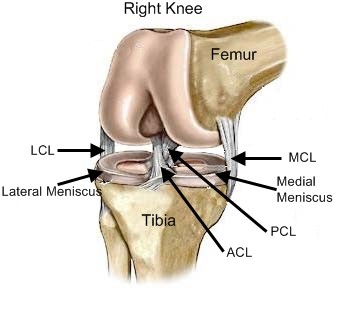
Anterior Cruciate Ligament (ACL) Injury by Janell Pierce
 The Anterior Cruciate Ligament (ACL) is one of the four main ligaments within the knee. It connects the thigh bone (femur) to the shin bone (tibia). This ligament is essential for jumping, bending and helps in stabilizing the knee. A torn anterior cruciate ligament is a serious knee injury, especially for athletes.
The Anterior Cruciate Ligament (ACL) is one of the four main ligaments within the knee. It connects the thigh bone (femur) to the shin bone (tibia). This ligament is essential for jumping, bending and helps in stabilizing the knee. A torn anterior cruciate ligament is a serious knee injury, especially for athletes.
Athletes who get ACL injuries usually play sports that have abrupt movement such as pivoting, stopping, or turning like football, basketball and soccer. People can also tear an ACL when they do movements they’re used to doing all the time, like jumping and landing hard on their feet. If the quadriceps muscles aren’t strong enough, a movement a player is used to doing can suddenly put too much pressure on the knee joint and cause the ACL to tear.
 What is an Anterior Cruciate Ligament?
What is an Anterior Cruciate Ligament?
The ACL is one of the four main ligaments in the knee joint. It connects the thigh bone (femur) to the shin bone (tibia). This ligament, along with the posterior cruciate ligament, crosses over it to form an “X”. Together these two ligaments help keep the knee stable and protects the femur from sliding or turning on the tibia.
How is it diagnosed?
Your health care provider will examine your knee and may find that the knee has become loose. You may need X-rays to see if there is an injury to the bones in your knee. An MRI (magnetic resonance imaging) scan may also be done and should clearly show the condition of your ACL.
How is it treated?
Use the R.I.C.E. treatment:
- Rest – Stop all activity immediately. Continued stress can increase the damage done to the ligament.
- Ice – Apply ice to the knee. Cold reduces the swelling, and easing pain.
- Compression – Apply Compression with an ace bandage. Compression helps to reduce swelling and will help stabilize the knee.
- Elevation – Elevate the injured limb above the level of the heart to help drain excess fluid from the area.
How can I prevent an ACL injury?
Unfortunately, most injuries to the ACL occur during accidents that are not preventable. However, you may be able to avoid these injuries by having strong thigh and hamstring muscles.
When can I return to my normal activity?
The goal of rehabilitation is to return you to your sport or activity as soon as possible. If you return too soon you may worsen your injury, which could lead to permanent damage. Everyone recovers from an injury at a different rate. Returning to your activity will be determined by how soon your knee recovers, not by how many days or weeks it has been since your injury occurred.
The information provided is for general interest only and should not be misconstrued as a diagnosis, prognosis or treatment recommendation. This information does not in any way constitute the practice of medicine, or any other health care profession. Readers are directed to consult their health care provider regarding their specific health situation. Marque Medical is not liable for any action taken by a reader based upon this information.
